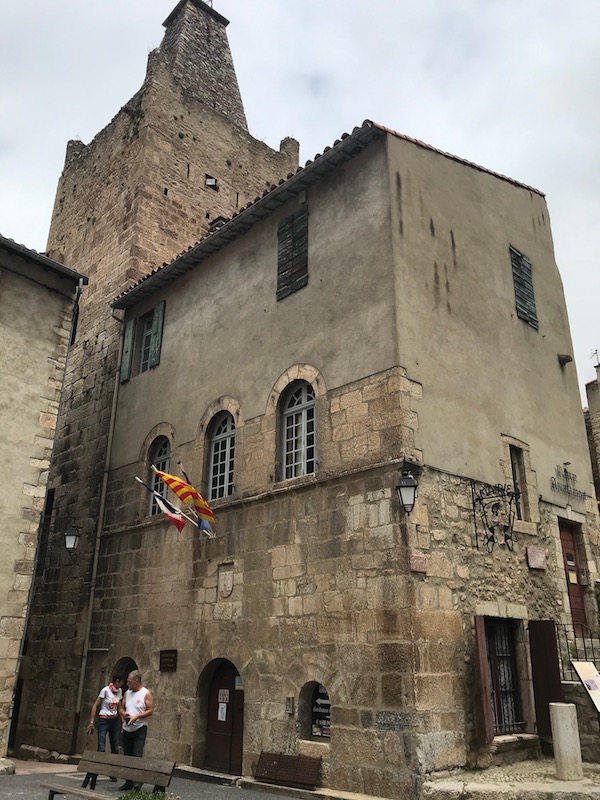Our Blog - The Pyrénées, Villefrance-de-Conflent
The "Conflent" is a natural area that is made up of (roughly) the high and medium valleys of the Têt River and is dominated by the Canigou (Canigó) Mountain to the south and the Madrès massif to the north. The town of Villefranche-de-Conflent is located at the confluence of the Têt and Cady rivers. The founding charter for the village was granted in 1091. During the 13th, 14th, and 15th centuries, the fortifications of the city were constantly updated. The city was besieged and taken by the French in 1654, who then dismantled the fortifications so that they could not be used by the Spanish. Then in 1669, new fortifications were built based on plans of Vauban (the French master of fortifications) including Fort Liberia, which was built on the mountainside overlooking the village. The village is now mainly a tourist attraction, with about 200 people actually living there.
The city is surrounded by an elongated rectangular enclosure, fully preserved, mixing elements from medieval reconstructions and additions of the 17th and 18th centuries. We ended up getting pictures from outside of the walls on two different sides, including some on the side where the Cady River passes by.







We entered through the Spanish Gate, which was reconstructed in 1791. There are still traces of the drawbridge (the chains on the outside) but it is now a fixed bridge. The town is known for the pink marble used to make the houses, that came from nearby quarries. Here you can see the pink marble forming the gate.

The town is organized around two parallel east-west streets. Almost all the houses date back to the Middle Ages. Most have been reworked and therefore have elements from different times. On the ground floor, they almost all have one or more large semicircular arches. Some facades still have twin windows or mullioned windows, and dates carved into the marble above the doors.




In the Middle Ages, tisserands (weavers of cloth) lived and worked in this street, hence the name Rue des Tisserands. They wove wool as well as linen and silk. Merchants would come from all over Europe to buy the fabric and lots of money flowed into the town. Due to this wealth, there were no taxes, which gives the town its name ... Ville Franche means "free town".

On the opposite end of the village from where we entered is the oldest gate, named the Count's Gate. It was built in the middle ages during the first expansion of the town. There is a narrow gatehouse on the outside and the passage is barred by a wooden portcullis (which you can see).

Dominating the city to the north, Fort Liberia was an integral part of the city's defense system. It was built by Vauban in 1681 after the division of Catalonia between France and Spain by the Treaty of the Pyrenees. Vauban considered that the stronghold of Villefranche-de-Conflent was too easily taken and therefore had to be reinforced by a fort on its heights. There is an underground stairway that connects the town to the fort that was built at the 19th century. All of the signs indicated that it was closed, so we could only get pictures from down below.




The building that houses the Town Hall has always been the seat of administrative and judicial power, attached to the Viguier's Tower that you will see next from a different angle. The building dates back to the 12th century. On the wall, you can see the arms of the town. It consists of two towers, a star, and some water. The water is for the confluence of the two rivers (the Têt and the Cady) where the river stands.



The Viguier's tower was built in 1200, and is integrated into the current Town Hall building. The Viguier was a judge who represented the legal and administrative power of the King, and so this tower was used as a prison. It is a 7-meter square tower, 20 meters tall, and topped with a pyramid-shaped belfry that was added in 1623 when the town obtained the right to have bells.


The Église Saint-Jacques sits on the main square of the town, and was built in the 12th century. It was built using the traditional pink marble and the great doorway is typical of Catalan Romanesque art. The capitols around the doorway has really nice carvings at the top.


Solanell's Tower has the same dimensions as the Viguier's Tower, with narrow vertical openings. It was used as a cistern and then an ice house, so there is no entrance door at the street level. The door was on the first floor (which is now a window) and the people would use a wooden ladder to climb up.

Many of the stores had these metal signs indicating the type of store.

